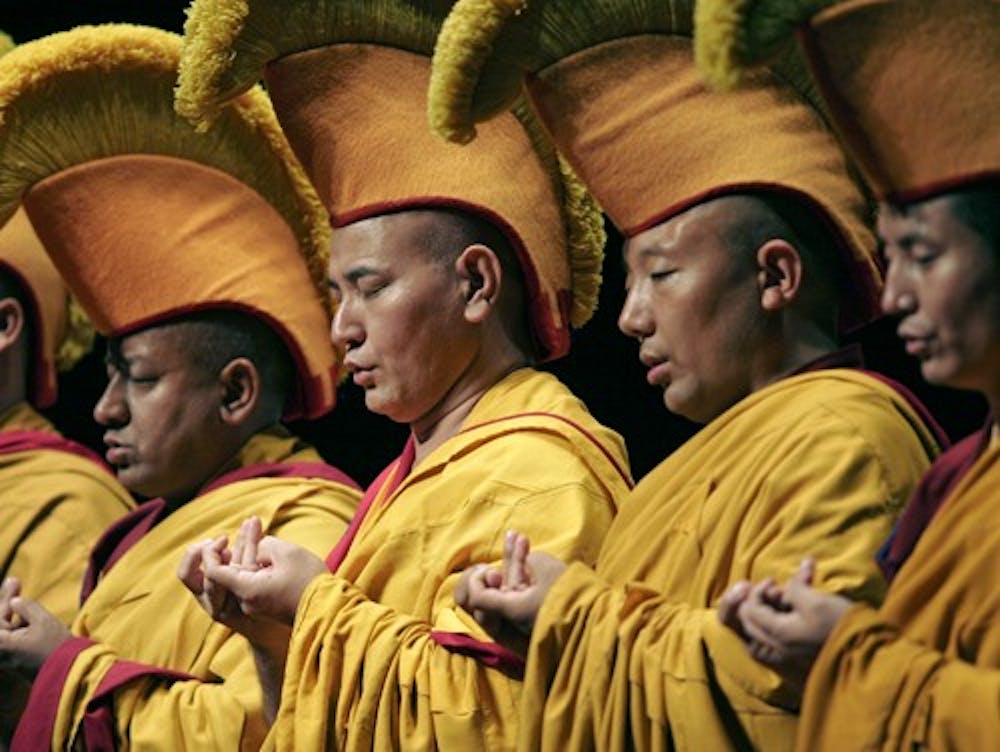A 60-foot tapestry of an intricate, colorful Buddha set the stage for a performance by the monks of the Drepung Gomang Monastery. Flanked by tables of chandeliers with lotus-shaped lights, the wall covering displayed the religious deity surrounded by five Buddhists saints. A large throne sat in the middle of the stage, where the monks placed a photo of the Dalai Lama.\n“Since he cannot be here with us physically, it is tradition that we place a photo of him where he would sit,” the narrator, known only as Gandhi, said.\nThe monks, from the same monastery as the Dalai Lama, presented their “Cultural Pageant of Tibet” on Thursday, demonstrating chants, dances, music and monastic debate as part of Tibetan Night at the IU Auditorium.\nThe Dalai Lama is in Bloomington this week to present a series of teachings Atisha Buddhism but could not attend Thursday’s event. His public lecture, “Compassion: the source of peace,” will be from 2 to 4 p.m. Saturday at Assembly Hall. Admission is $15 for students and $30 for general admission.\nThe exhibition began with a traditional chant used by this particular sect of monks, and is used to welcome the Dalai Lama and to offer him the newly constructed sand mandala.\nGandhi explained the purpose of the chant beforehand to the audience of more than 1,000 students and community members. \n“The chant is a motion to send forth into the world healing and world peace,” he said. \nAfter the introduction, several monks filed on stage carrying instruments and saffron-colored headdresses. Grouping themselves in a line, they began their chant in Tibetan.\nThe chants lasted only a few minutes, and the monks transitioned to a scene from a Tibetan opera. \n“In 1645, Thangthong Gyalpo founded the Tibetan opera,” Gandhi said. “The monks performing the dance will be wearing masks that represent him.” \nThe purpose of the dance is to bring good luck, he said. \nThe monks’ headdresses were adorned with shaggy white hair, resembling an old, archaic-looking man. Their suits included a colorful shawl and shoes contrasted with black and white-striped pants.\nThe dancers kept in rhythm with a bass drum and cymbals, played by monks, and chanted aloud as they jumped and waved their intricately adorned staffs. \nStill performing as they danced off the stage, Gandhi returned and introduced the next act of the pageant. \n“In monasteries, it is typical for monks to debate philosophic ideas,” he said. \nIn the monastic debates, there are two parties, he explained. A defender must answer questions asked by the challengers. \nWhile most of the monks sat in a line, two younger looking men settled away from the group as defenders. Two more stood and served as moderators to the debate, adding animation and liveliness to the demonstration. \nBetween the clapping, pointing and stomping, the defenders appeared to have made their cases successfully. Since the demonstration of the debate was in Tibetan, much of the audience was not able to tell who actually won the debate. \nFreshman and IU Auditorium usher Alexis Suskin-Sperry expressed her excitement about Tibetan Night and the Dalai Lama’s visit to Bloomington. \n“His presence (Wednesday) just struck me,” she said. “He has such a stage presence, and I really felt touched. He emits so much kindness, and you can just feel his energy.”
Tibetan traditions
Monks from around the world flock to Bloomington to celebrate the Dalai Lama’s visit

Get stories like this in your inbox
Subscribe





